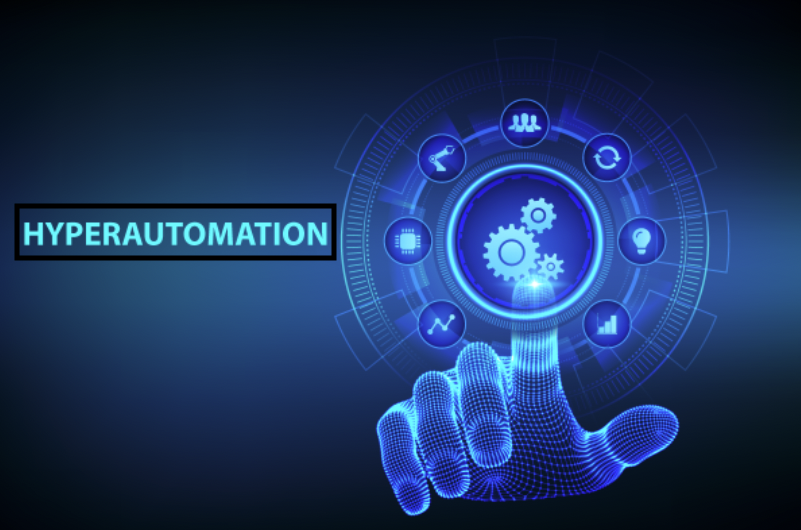
Hyperautomation is the use of technologies to scale the automation of processes within an organization.
One example of hyperautomation is the usage of Optical Character Recognition (OCR) to understand documents.
The global hyperautomation market is expected to reach $2.2B by 2030 (a CAGR of 18%).
Hyperautomation technology in the manufacturing industry is set to be a significant driver of this growth.
Table of Contents
Best Hyperautomation Platforms
Let’s take a look at the best hyperautomation platforms.
#1 Mulesoft Composer
Mulesoft Composer is an hyperautomation platform that enables businesses to quickly and easily connect their data, applications, and devices.
With Mulesoft Composer, organizations can take a low-code approach to hyperautomation, making it easy to get started and scale as needed.
#2 Automation Anywhere
Automation Anywhere is a leading hyperautomation platform that helps organizations automate their business processes.
With Automation Anywhere, organizations can quickly and easily automate their manual processes, saving time and money.
#3 UiPath
UiPath is another leading hyperautomation platform that helps organizations automate their business processes.
UiPath offers a wide range of features and capabilities, making it easy to automate repetitive tasks.
#4 Blue Prism
Blue Prism helps you automate tasks.
Blue Prism makes enterprise robotic process automation software that provides a digital workforce designed to automate complex, end-to-end operational activities.
What’s next for Hyperautomation
Hyperautomation is part of the Robotic Process Automation (RPA) Technology meta trend.
According to Gartner, 80% of finance executives have made plans to implement RPA within their organization.
And Deloitte estimates that 78% of the companies that have already implemented RPA plan to significantly increase investment in this area in the next three years.
Which explains why the global RPA market is forecasted to grow at a CAGR of 33% through 2030.
And, as Deloitte puts it, if this growth trend continues, RPA will approach a “near universal adoption” within the next 5 years.
Hyperautomation FAQ
What is hyperautomation used for?
Hyperautomation can be used for a variety of tasks, including (but not limited to):
- automating manual processes
- reducing repetitive tasks, and
- improving efficiency
What is RPA and hyperautomation?
RPA is a type of hyperautomation that helps organizations automate their business processes.
Hyperautomation is the use of technologies to scale the automation of processes within an organization.
What are the benefits of hyperautomation?
The benefits of hyperautomation include improved efficiency, reduced costs, and increased productivity.
What is the future of hyperautomation?
The future of hyperautomation is bright. The global RPA market is forecasted to grow at a CAGR of more than 30% through the end of the decade.
What is a hyperautomation example?
An hyperautomation example is the usage of Optical Character Recognition (OCR) to understand documents.
OCR is a type of hyperautomation that can be used to automate manual tasks, such as data entry.
What are the best hyperautomation platforms?
The best hyperautomation platforms include Mulesoft Composer, Automation Anywhere, and UiPath.
How much does hyperautomation cost?
The cost of hyperautomation can vary depending on the hyperautomation platform you choose and the size of your organization.
Hyperautomation platforms typically offer a free trial, so you can try before you buy.
Hyperautomation is an important tool for businesses looking to improve efficiency and productivity.
The best hyperautomation platforms offer a variety of features and capabilities to help organizations automate their business processes. With hyperautomation, businesses can save time and money by automating tasks and processes.
How do I get started with hyperautomation?
The best way to get started with hyperautomation is to choose a hyperautomation platform that fits your needs.
Many hyperautomation platforms offer a free trial, so you can try before you buy. Once you’ve selected a platform, you can start automating your business processes.
Who invented hyperautomation?
Hyperautomation was a term that was brought into popularity by IT firm Gartner in 2019.
What is the difference between automation and hyperautomation?
The difference between automation and hyperautomation is that hyperautomation is the use of technologies to scale the automation of processes within an organization.
Automation is the use of technology to automate tasks or processes.
What are the types of hyperautomation?
There are two types of hyperautomation:
- process-based hyperautomation and
- decision-based hyperautomation
Process-based hyperautomation automates repetitive tasks.
Decision-based hyperautomation automates decision-making processes.
What is hyperautomation software?
Hyperautomation software is a type of software that helps businesses automate their business processes.
Hyperautomation software typically includes features such as workflow management, process mapping, and automated task execution.
Is intelligent automation same as RPA?
No, intelligent automation is not the same as RPA. Intelligent automation is a type of hyperautomation that uses artificial intelligence and machine learning to automate tasks.
RPA is a type of hyperautomation that helps organizations automate their business processes.
How does hyperautomation work?
Hyperautomation typically includes a combination of tools, including workflow management, process mapping, and automated task execution.
Hyperautomation can be used to automate tasks, processes, or decision-making.
Is RPA or AI better?
RPA is great for automating easy generic tasks.
However, when business processes are more complicated or require the ability to more complex or creative thought or processes, Artificial Intelligence can take automation to the next level.
What are the benefits of hyperauomtation?
Some benefits of hyperautomation include:
- Increased efficiency and productivity
- Reduced costs
- Improved accuracy and quality
- Accelerated time to market
- Improved customer satisfaction
Conclusion
Hyperautomation is a powerful tool that can help businesses automate their business processes.
The best hyperautomation platforms offer a variety of features and capabilities to help organizations automate their business processes.
With hyperautomation, businesses can save time and money by automating tasks and processes.


![Backwards 3: How to Type "Ɛ" [EASY]](https://softwareblade.com/wp-content/uploads/2022/02/Screen-Shot-2022-02-19-at-9.03.25-PM-150x150.png)